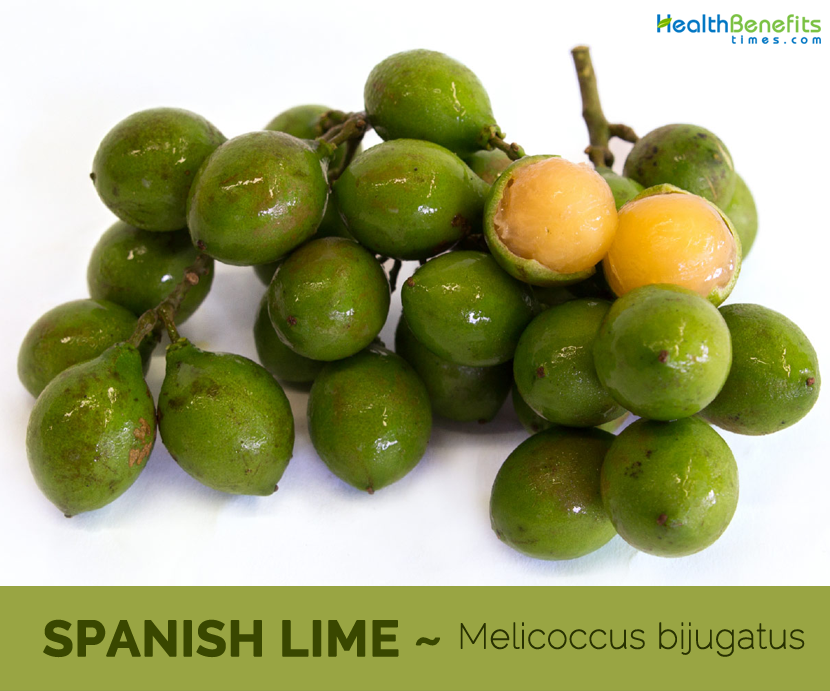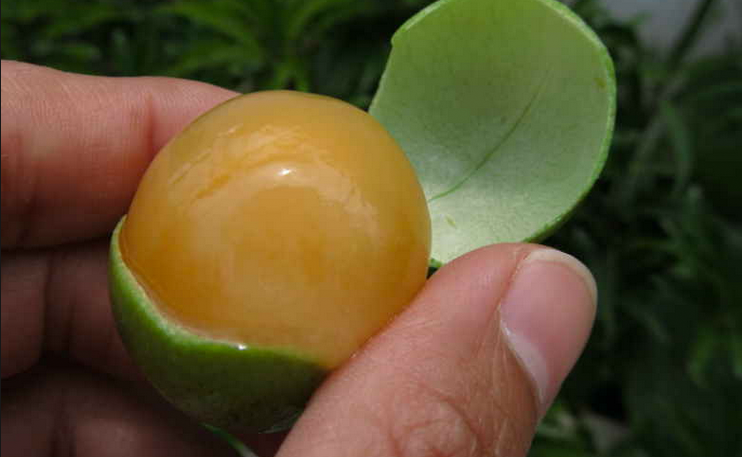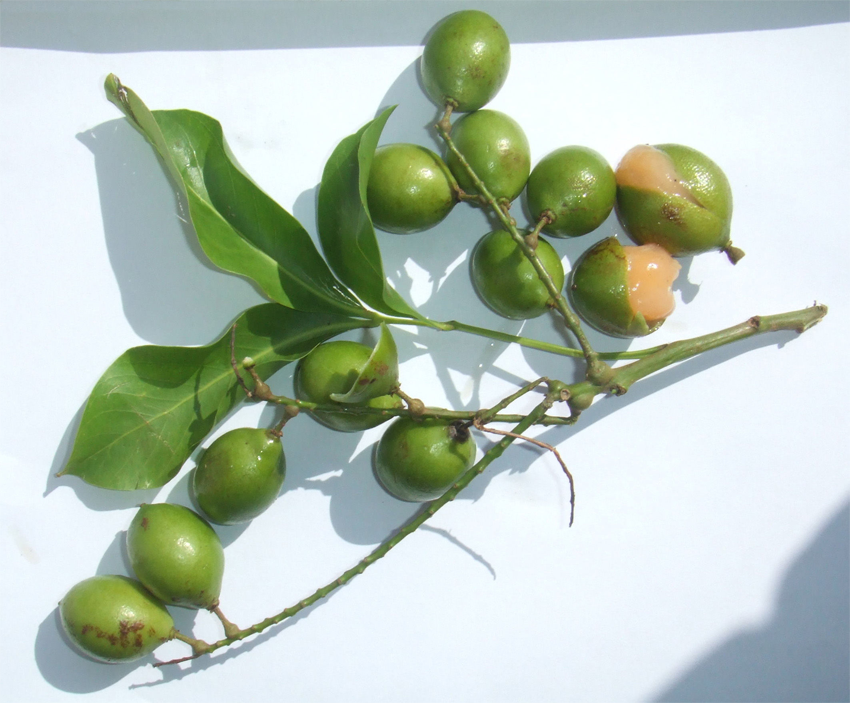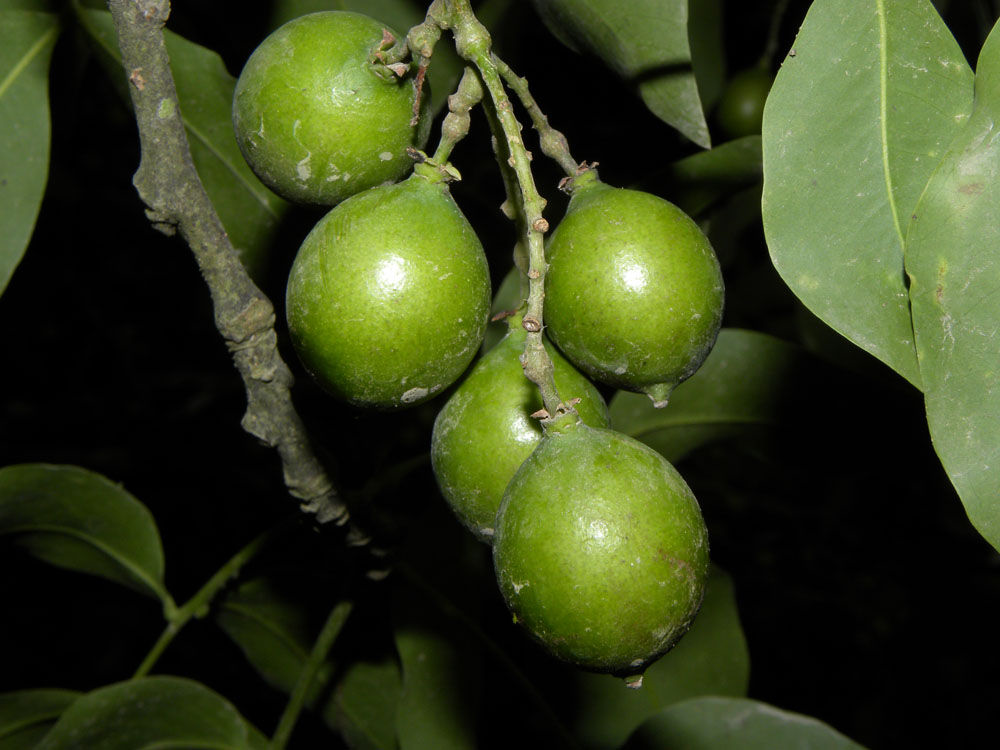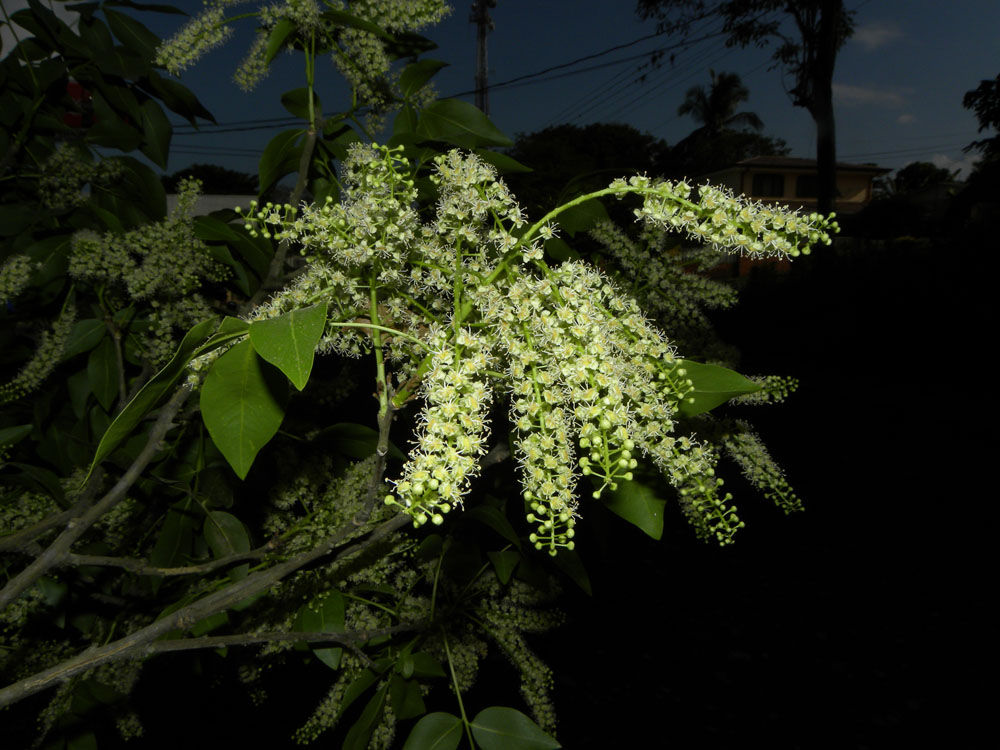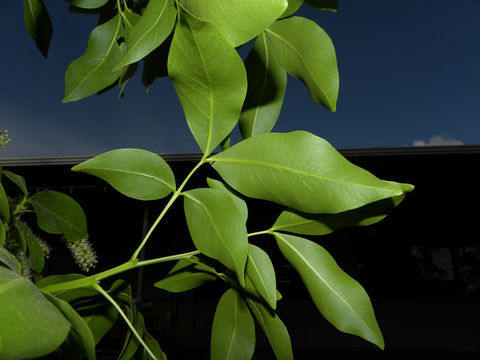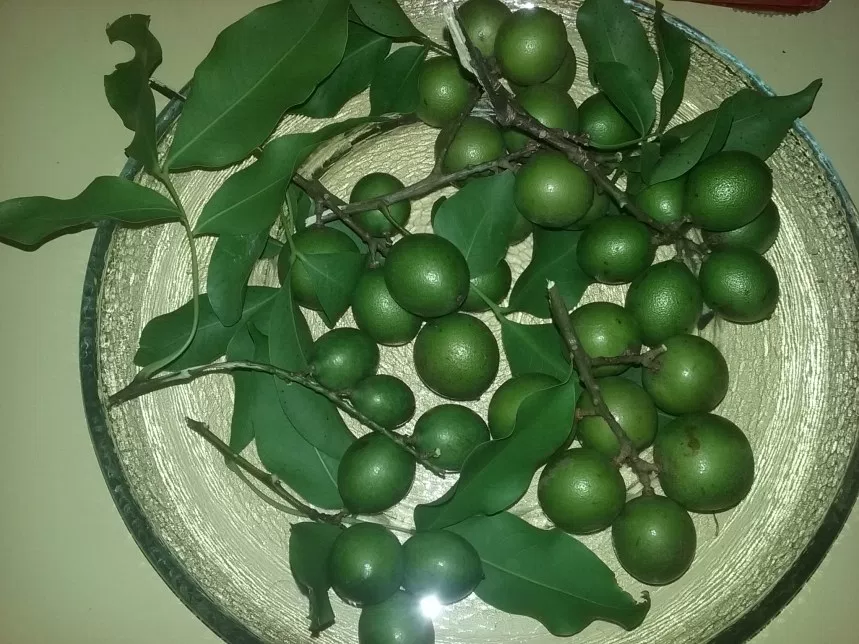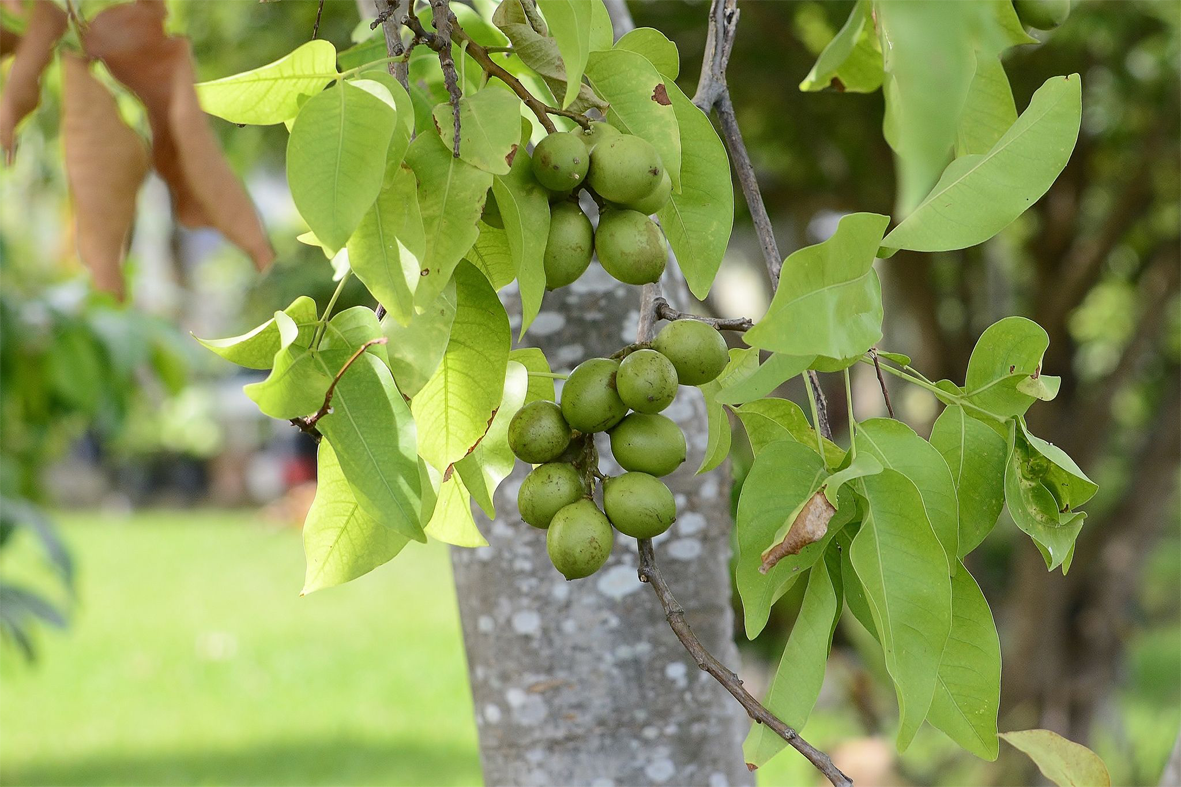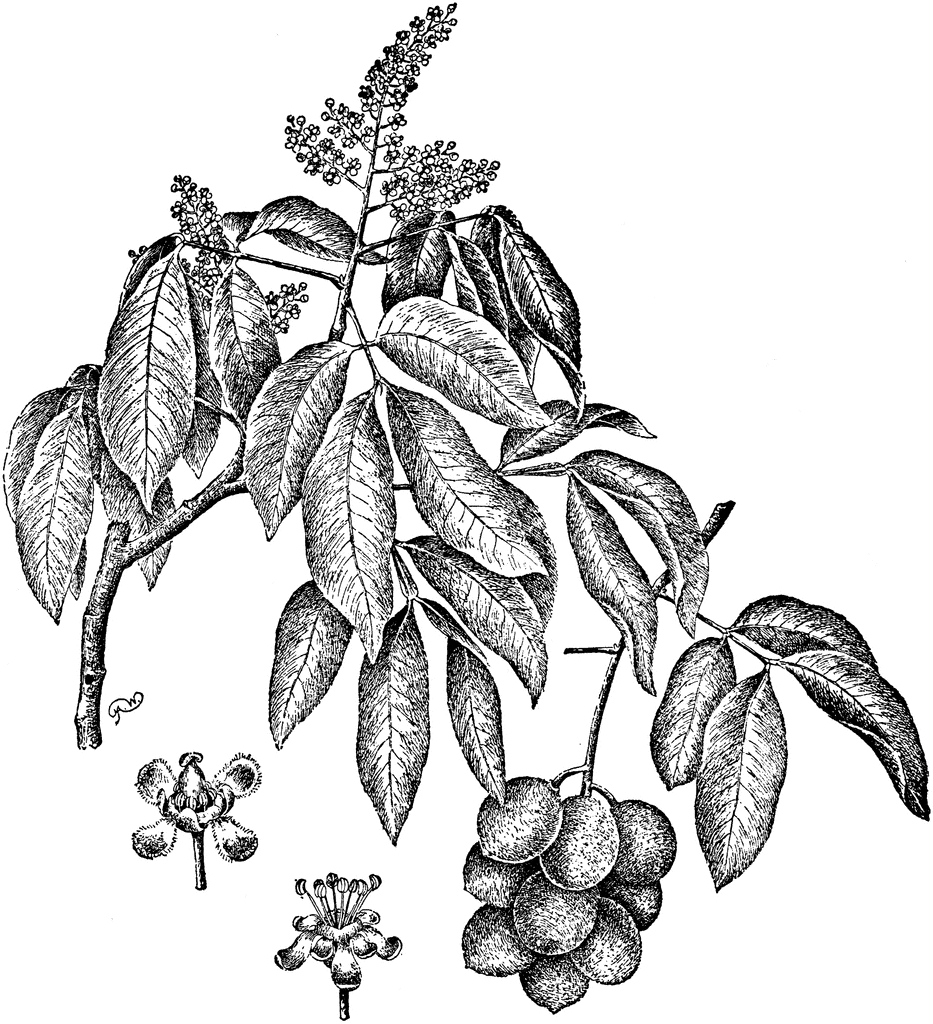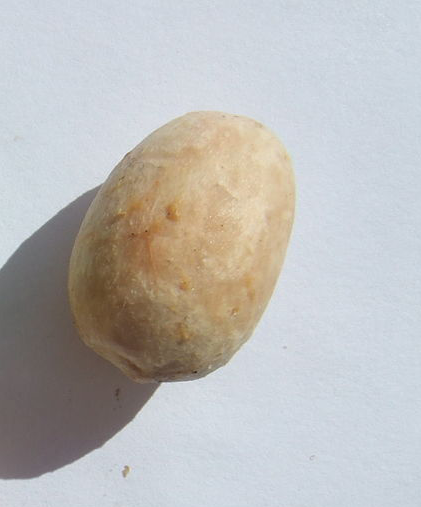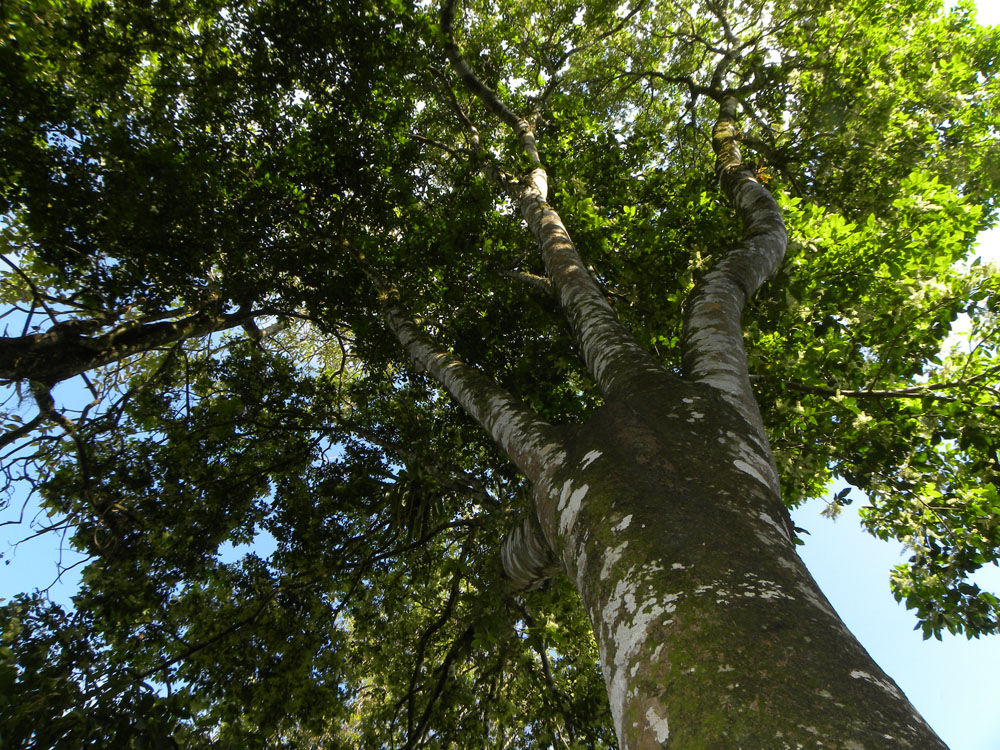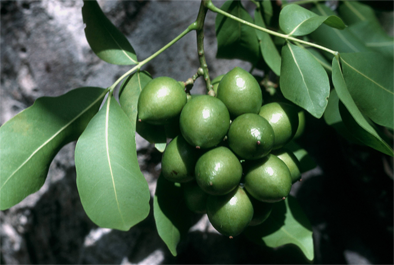Description
Spanish lime is a dioecious or monoecious tree, slow-growing and erects growing up to 85 ft. (25 m) high and spread vigorously. It is found growing in secondary forests, coastal forests, old farmsteads, and along roadsides. It is drought tolerant but serious damage inflict if exposed in frost. It can be grown in variety of soil type, poor to rich and sandy but soil should be well drained. Trunk is 5 1/2 ft. (1.7 m) thick and smooth with light grey, thick, smooth bark with horizontal markings. Stem is glabrous.
Leaves
Leaves of M. bijugatus are paripinnate; early deciduous; leaflets (2) 4, opposite or sub-opposite, asymmetrical, elliptic, oblong, ovate or obovate, 4-14(20) × 2.2-5(7) cm, chartaceous, glabrous on both surfaces; the margins are entire, slightly wavy, the apex acute or obtuse. The rachis is frequently winged.
Flowers
Spanish lime flowers are borne on terminal panicles, 5-12 cm long, glabrous, the staminate inflorescences with 4-8 lateral branches, slightly shorter than the main axis, the pistillate inflorescences with 3-4 mostly basal, short branches; bracts triangular, minute, ciliate at margins; pedicels (2)5- 7 mm long, not articulate. Flowers fragrant; sepals 4, greenish, 1.5-2.2 mm long, oblong, concave, glabrous except for the woolly margins; petals 5, cream to yellowish, obovate, 2-2.5 mm long, narrowed at base, rounded at apex, woolly to sparsely woolly at margins; nectary disc annular, lobed, glabrous; stamens 8 , spreading, the filaments of unequal length, glabrous, ca. 4 mm long in male flowers; ovary glabrous, the style ca. 0.5 mm long, the stigmas bilobed or bilobed-disciform, papillate.
Fruit
Spanish lime fruits are borne in clusters and are sub-globose or ellipsoid green drupes, 2-3.5 cm long and 10-25 g in weight, green to yellowish when mature with a thin, leathery, brittle skin. The fruits have a short, sharp terminal protrusion. The pulp is a gelatinous aril that is juicy and tart or acid-sweet, translucent, somewhat astringent, orange to salmon pink, and contains one relatively large seed to which the aril is firmly attached. Seed is large, 1.5-2.5 cm long, yellowish-white or white, hard-shelled, starchy and astringent. Some trees produce a proportion of fruit with two hemispherical seeds. When the fruit is ripe, the pulp is sweetly acidic and has been compared to a cross between a lime and a lychee.
Health benefits of Spanish lime
This small round fruit is about the size of an olive with a hard skin. Inside you’ll find a very sweet luscious fruit with a jelly like consistency, most people eat them fresh… but they can also be made into sauces, desserts, and juice. Listed below are some of the health benefits of Spanish lime
1. Promotes Healthy Eyes
Spanish lime consists of good amount of vitamin A. Vitamin A is very important to maintain healthy eyes. Vitamin A deficiency can lead to Nyctalopia, a condition where it is difficult or impossible to see in low light. Vitamin A also boosts immune system, which is great to fight infections, especially viral infections like common colds.
2. Promotes Good Sleep
Spanish lime is quite beneficial for promoting good sleep. Meanwhile, Spanish lime is high in tryptophan, an amino acid which is important for good sleep. It also contains lysine, an amino acid which is important to promote proper growth and maintain healthy appetite. We know that most of our body cells grow and regenerate at night, when we sleep. So, the combination of tryptophan and lysine in the Spanish lime is very good for our body.
3. Improves your urinary system
Vitamin A found in Spanish lime is an essential nutrient for the body’s urinary system. Research has shown that an increase in vitamin A decreases the risk of urinary infections by over two-thirds. Since Spanish limes are packed full of vitamin A and are recommended for anyone who suffers regularly with bladder infections.
4. Lowers Blood Pressure
Spanish lime is full of antioxidants (phenolic compounds), which play an important role in reducing the damages in blood vessels caused by free radicals. Healthy blood vessel will make the heart put less effort in pumping the blood, therefore lowering blood pressure. Combined with the effect of lowering cholesterol, consuming Spanish lime can keep us away from cardiovascular diseases.
5. Stabilizes your mood
In many tropical countries, Spanish lime is recommended as a good natural remedy for mood instability and anxiety. The concentrated minerals, antioxidants and organic acids found in Spanish lime help the level of neural transmitters return to normal. This in turn removes unexplained anxiety and mood swings.
6. Prevents Anemia
Spanish lime consists of good amount of Iron, a mineral required to produce healthy red blood cells. Iron deficiency can lead to Anemia, a condition where the number of healthy red blood cells is less than normal. So include Spanish lime on your every day schedule to prevent from Anemia.
7. Builds up your immune system
Phosphorous present in Spanish limes is also proven to boost your immune system to fight off infections and illness.
Research by the University of Hohenheim found that supplementing the diet of pigs (which have a very similar digestive tract as humans) with phosphorous boosted their immune system and lowered the number of illnesses they contracted.
8. Helps Weight Loss
Spanish lime is low in calories, contains no fat at all, but high in fiber and it helps to lower cholesterol. If you want to lose weight, then you can eat Spanish lime all in your menu for a day long. It will keep us busy, plus we will feel full longer because of the fibers.
This is absolutely the best way to lose weight, without abstaining too much from nice foods. All of us know that obesity will lead to cardiovascular diseases (such as hypertension, stroke, and heart diseases), so it is a good idea if we want to lose weight.
9. Maintains Healthy Digestive System
Spanish lime consists of good amount of fibers which is quite essential for preventing constipation by absorbing water from outside of colon and increase the mass of the stool. The fibers also help curing diarrhea by absorbing excessive water from the stool. Seeds of Spanish lime can be roasted, crushed and mixed with honey to sooth away diarrhea. Moreover, the leaves can be boiled and the decoction is taken to treat intestinal problems.
10. Maintains Healthy Bones and Teeth
Spanish lime and the seeds consist of calcium which is actually an important mineral for the maintaining healthy bones and teeth. Regular calcium intakes prevent us to get osteoporosis. Seeds are high in phosphorus, which together with calcium promotes healthy bones and teeth. Consume Spanish lime regularly to maintain healthy teeth and bones naturally.
11. Anti-Diabetic
Although Spanish lime consists of good amount of sugar, the sugar is in fructose form, which is more difficult to absorb than simple glucose. There are several researches claiming that Spanish lime has some protein substances which lower blood glucose level. The fibers also help preventing excessive sugar absorbed into bloodstream. Thus Spanish lime is beneficial for preventing diabetes.
https://www.youtube.com/watch?v=_r9ru-QegaI
History
Spanish lime is native to Colombia, Venezuela, and the island of Margarita, also French Guiana, Guyana and Surinam. It is commonly cultivated and spontaneous in those countries, also in coastal Ecuador, the lowlands of Central America, the West Indies and in the Bahamas. In Florida, it is occasionally grown as far north as Ft. Myers on the West Coast and Palm Beach on the east; is much more plentiful in Key West, especially as a street tree. There are some specimens in California and in botanical gardens in the Philippines, Zanzibar, Hawaii and elsewhere. According to Britton, there was a tree about 30 ft. (9 m) tall in Bermuda in 1914 but it had never bloomed. There are a few trees in Israel but none has flowered before 10 years of age.
Nutritional Value
Apart from their taste often compared to lime and a lychee, Spanish lime is a good source of nutrients, vitamins and minerals. Consuming 100 gram of Spanish lime offers 16.35 g of Carbohydrate, 0.83 mg of Iron, 0.12 mg of Vitamin B1, 0.105 mg of Vitamin B2, 5.4 mg of Vitamin C, 1.33 g of Total dietary Fiber and 0.525 mg of Vitamin B3.
Other Uses of Spanish lime
a. Substitute of Cassava Flour
People in South America use Spanish lime seeds as substitute of cassava flour for baking. The seeds are roasted and ground. This is especially important for people with gluten allergy, since they cannot consume wheat flour at all; thus they have to replace wheat flour with cassava flour or Spanish lime flour.
b. Ornamental Plants
The tree, especially when flowering, is very beautiful. In Latin America and Caribbean (Puerto Rico, Equador, Bolivia, Columbia, Dominican, Mexico, Bahamas, etc.) the trees are often used as ornamental plants in front yards or on side roads. Ornamental plants are important, since it can produce oxygen and absorb carbon dioxide, making the air more fresh and healthy. When we live in healthy air, we will feel more energized
c. Natural Fabric-dye
The juice from the fruit gives dark-brown stain when it touches any fabric. The indigenous Arawak people use the juice to dye their clothes.
d. Honey
The flowers are rich in nectar and extremely appealing to hummingbirds and honeybees. The honey is somewhat dark in color but of agreeable flavor. The tree is honored by Jamaican beekeepers though the flowering season (March/April) is short.
e. Kills Fleas
In Panama, the leaves are scattered in houses where there are many fleas. It is claimed that the fleas are attracted to the leaves and are cast out with the swept-up foliage. Some believe that the leaves actually kill the fleas.
f. Wood
The heartwood is yellow with dark lines, compact, hard, heavy, fine-grained; inclined to decay out of doors, but valued for rafters, indoor framing, and cabinetwork.
Traditional Medicinal uses of Spanish lime
- Pulverized, roasted seed kernels and a decoction of bark or leaves are used for dysentery and intestinal disorders.
- Tea made from young leaves is used in the Dominican Republic to reduce fever.
- Leaves of the Spanish lime tree can be boiled and made into a tea which is great for intestinal problems.
- Seeds are roasted, crushed and combined with honey as an antidote for diarrhea.
Culinary uses
- It is made into jam, marmalade, jellies or beverages and the peeled fruit can be boiled to make a cold drink.
- Seeds are said to be edible after roasting.
- Indians of the Orinoco River basin use the cooked seeds as a substitute for cassava.
- Spanish lime is best eaten fresh, out-of-hand.
- Spanish lime can be used to make simple syrup that can be used in desserts and drinks.
- In Ecuador, Spanish lime is eaten with salt and chili.
- It is often cooked with meat and poultry.
- The juice can be cooked to make simple syrup and used in various sauce, desserts and jelly.
- Fresh fruit juice also can be added to cocktails.
Other Facts
- It is actively planted as an ornamental, shade tree, and honey-plant.
- Flower nectar allows the production of an appreciated dark, flavored honey.
- The wood is valued for rafters, indoor framing and cabinetwork.
- Extracts from the leaves are used in South America to kill flies and repel sandflies.
Precautions
- Unripe fruits are poisonous.
- Since the juice from the fruit can stain the clothes, we should peel the skin carefully.
- We should take cautions on the big seeds too, since it can cause choking hazards in children.
References:
http://www.theplantlist.org/tpl/record/kew-2509977
http://davesgarden.com/guides/pf/go/102874/
http://www.hear.org/pier/species/melicoccus_bijugatus.htm
https://npgsweb.ars-grin.gov/gringlobal/taxonomydetail.aspx?id=70440
http://www.cabi.org/isc/datasheet/33184
https://www.itis.gov/servlet/SingleRpt/SingleRpt?search_topic=TSN&search_value=28691#null
https://plants.usda.gov/core/profile?symbol=MEBI
https://en.wikipedia.org/wiki/Melicoccus_bijugatus
https://www.hort.purdue.edu/newcrop/morton/mamoncillo.html
Comments
| Spanish Lime Quick Facts | |
|---|---|
| Name: | Spanish Lime |
| Scientific Name: | Melicoccus bijugatus |
| Origin | Northern South America |
| Colors | Green to yellowish |
| Shapes | Sub-globose or ellipsoid green drupes, 2-3.5 cm long |
| Flesh colors | Salmon-colored or yellowish |
| Taste | Pleasantly acid-sweet |
| Calories | 65.55 Kcal./cup |
| Major nutrients | Carbohydrate (12.58%) Iron (10.38%) Vitamin B1 (10.00%) Vitamin B2 (8.08%) Vitamin C (6.00%) |
| Health benefits | Lowers Blood Pressure and Stabilizes mood |
| Name | Spanish Lime |
|---|---|
| Scientific Name | Melicoccus bijugatus |
| Origin | Northern South America, from Colombia to the Guianas, and Central America and the West Indies |
| Common Names | Spanish Lime, Mamoncillo, Guayo, Honeyberry, Limoncillo, quenepa, genip, canepa, ginepa, genipe, kinip, quenepe, chenet |
| Name in Other Languages | Brazil: Pitomba Danish: Honningbær Dominican Republic: quenepe; quenepo English: Ackee, Genip, genip lime, geniptree, ginep, ginepe, guenepa, guinep, honeyberry, jamaica bullace plum, kanappy, knippelboom, mamoncillo, quenepa, Skinup, Spanish lime French: Kenettier, kenépier, knépier or quenettier, quenepe, quenette German: Dotterknippe, Honigbeere, quenepa Haiti: Canapé; quenepe a fruits; quenépier; quenépier male Jamaica: Ginep; guinep Lesser Antilles: Ackee; chennet; Jamaica bullace plum Nicaragua: Escanjocote Portuguese: Arvore de canopy Spanish: Grocella de miel, kenepe, limoncillo, Macao, Maco, mammon, mamoncillo, mammon, mamón de Cartagena, mauco, muco, quenepa Suriname: Knippen Swedish: Honungsbär Tahitian: Kneti, koneti, kōneti, kōneti United States Virgin Islands: Genep |
| Plant Growth Habit | Dioecious or monoecious tree, slow-growing and erect |
| Growing Climate | Found growing in secondary forests, coastal forests, old farmsteads, and along roadsides. |
| Soil | Well drained |
| Plant Size | 85 ft. (25 m) high |
| Bark | Thick, light grey, smooth, with horizontal markings |
| Trunk | 5 1/2 ft. (1.7 m) thick; smooth |
| Stem | Glabrous |
| Leaf | Briefly deciduous, alternate, compound, having 4 opposite, elliptic, sharp-pointed leaflets 2 to 5 in (5-12.5 cm) long and 1 1/4 to 2 1/2 in (3.25-6.25 cm) wide |
| Flower | Slender racemes 2 1/3 to 4 in (6-10 cm) long, often clustered in terminal panicles, are fragrant, white, 1/5 to 1/3 in (5-8 mm) wide, with 4 petals and 8 stamens. Male and female are usually borne on separate trees but some trees are partly polygamous. |
| Fruit Shape & Size | Sub-globose or ellipsoid green drupes, 2-3.5 cm long |
| Fruit Color | Green to yellowish |
| Fruit Weight | 10-25 g |
| Fruit Skin | Smooth, thin but leathery and brittle |
| Flesh Color | Salmon-colored or yellowish, translucent, gelatinous, juicy but very scant and somewhat fibrous, usually clinging tenaciously to the seed |
| Taste | Fully ripe is pleasantly acid-sweet but if unripe acidity |
| Seed | Single, large, yellowish-white, hard-shelled seed, while some have 2 hemispherical seeds |
| Kernel | White, crisp, starchy, and astringent |
| Major Nutrition | Carbohydrate 16.35 g (12.58%) Iron, Fe 0.83 mg (10.38%) Vitamin B1 (Thiamin) 0.12 mg (10.00%) Vitamin B2 (Riboflavin) 0.105 mg (8.08%) Vitamin C (Ascorbic acid) 5.4 mg (6.00%) Total dietary Fiber 1.33 g (3.50%) Vitamin B3 (Niacin) 0.525 mg (3.28%) Tryptophan 0.014 g (3.18%) Phosphorus, P 16.85 mg (2.41%) Protein 0.75 g (1.50%) |
| Calories in (100 gm) | 65.55 K Cal |
| Health Benefits |
|


